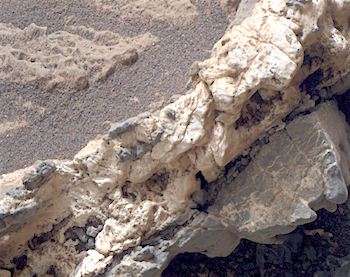 [Ed note: Post by planetary geologist Susanne Schwenzer, The Open University, Milton Keynes, UK]
[Ed note: Post by planetary geologist Susanne Schwenzer, The Open University, Milton Keynes, UK]
Sometimes planetary geology is like forensics. We are presented with a crime scene: Something broke down the original igneous rock, and made all those clays, veins and hematite nodules. We know this something was a fluid, but in order to find out exactly what has happened, we need to examine all the evidence we have. That often starts with investigating the images, and in great detail. That’s when we look at Mastcam images for the geologic context, then RMI and/or MAHLI for the close-up details. But what about the chemistry?
We are a small team here in the UK, specializing in what is called “thermochemical modelling.” Thermochemical modelling uses mathematical equations that are based on known reactions of minerals with water. The models combine many thousands of such reactions into equations, which can be solved iteratively to arrive at a reaction path for a known rock composition. And once we determine what reacted and how, we can also infer which chemical elements remained in the water because they were not included in the reaction products.
In other words, we can find out how the chemical elements are distributed between the fluid and the newly forming minerals. Some of our French and American colleagues use this method too, and we always have great discussions to advance our work. We take all the data that we have, images and chemistry from ChemCam and APXS, and where available also mineralogy from CheMin. That’s the evidence at our crime scene. But who broke the rock and left all those clays and white veins? [More at link]








